Second Half Evolution Test 1
1/65
There's no tags or description
Looks like no tags are added yet.
Name | Mastery | Learn | Test | Matching | Spaced |
|---|
No study sessions yet.
66 Terms
What do 0 and 1 equal when it comes to reconstructing phylogenies using character states?
0= ancestral, 1= derived
What is a homoplasy?
character state similarity not due to common descent
What is convergent evolution? (a type of homoplasy)
independent evolution of similar traits in separate
lineages (example: streamlined body form of dolphins and fish)
What is evolutionary reversal? (a type of homplasy)
reversion back to an ancestral character state (Example: Most frogs do not have lower teeth, but the ancestor of frogs did. One frog genus has regained teeth in the lower jaw)
is evolutionary reversal more common in DNA or morphology?
DNA
What is Dollo’s law?
structures that are evolutionarily lost will not be regained (not true)
What is the parsimony principle?
The simplest explanation of observed data is the preferred explanation. This minimizes the number of
evolutionary changes that must be assumed—the
fewest homoplasies.
What are other criterion for selecting a best estimated tree?
Maximum Likelihood, Bayesian, (Neighbor-Joining)
What happens if there are more than one parsimony tree?
construct a consensus tree (can have a polytomy)
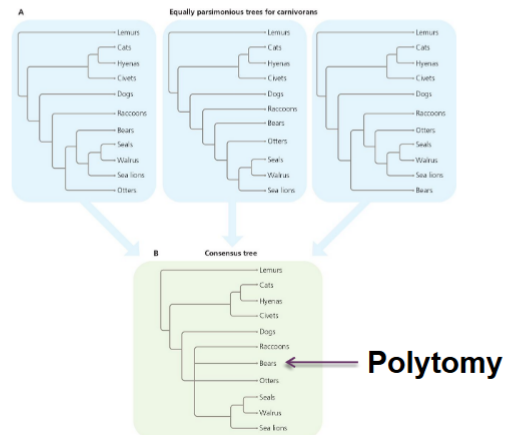
What is fixation? (genetic variation)
When an allele frequency = 1. (all homo dom or all homo recessive)
Natural selection works on what?
phenotypic variation
What is ploidy?
Number of copies of unique chromosomes in a cell
What is the order from DNA to protein?
DNA (template)→transcription→mRNA→translation→protein
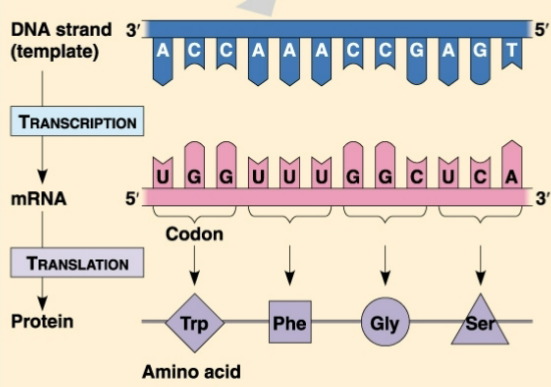
Gene expression (more detailed)
promoter region binding→ assembly of mRNA via RNA polymerase(transcription)→ introns removed by spliceosome→ ribosome grabs three bases at a time (aa brought by tRNA) (translation)
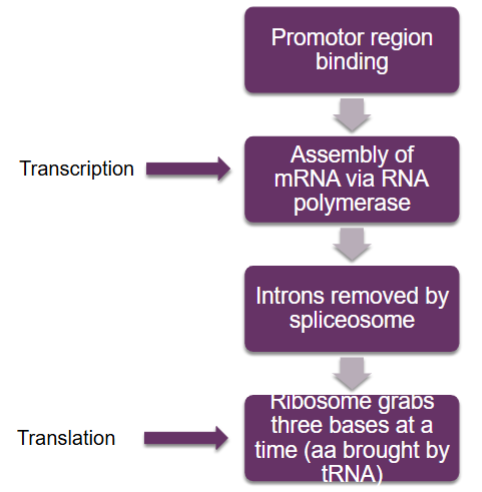
True or false: most protein-coding genes are “housekeeping”
False
What happens during transcription?
-binding of transcription factors, hormones and other repressors
-methylation of DNA
What is the point of binding transcription factors, hormones and other repressors in transcription?
controls when genes are expressed and how much RNA is produced
What does methylation do in transcription?
Can silence genes/prevent transcription
Can be passed to daughter cells (epigenetic)
Why your eye stays your eye
What happens post-transcription?
modification of RNA (introns and exons), alternative splicing
What happens during translation?
Binding of regulatory proteins, microRNA or ribosomal subunits (can influence whether translation is initiated)
What happens during post-translation?
Cleavage of amino acid chains, binding of subunits, phosphorylation
Can alter the structure and function of a protein as well as activate or silence it
What is a mobile genetic element?
parasite-like segments of DNA that can make new
copies of themselves (over half of human genome)
DNA Replication
Helix unwinds and both antiparallel strands are copied
simultaneously
Requires the cooperation of over a dozen enzymes and other
proteins
Happens very quickly
Up to 500 nucleotides per second
Few hours to copy 6 billion bases in a human cell
very accurate
When are DNA replication mistakes important?
during MEIOSIS/gamete formation
(creation of new alleles)
True or false: spontaneous mutation rate varies between organisms
True
What is point mutation?
Switch out one base for another
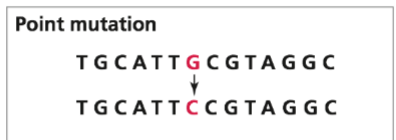
What is insertion?
Adding a new segment of DNA
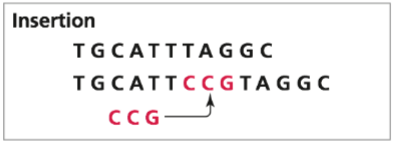
What is deletion?
loss of a segment of DNA
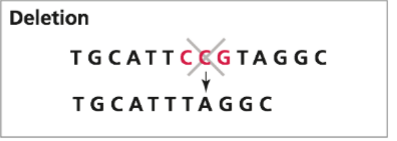
What are the types of point mutations or base substitutions and what do they mean?
Synonymous = silent
Missense = nonsynonymous
Nonsense = makes a stop codon, often inactivates protein
Mutations only have a detectable impact (create new alleles) if
they:
1. Cause change in amino acid sequence
2. And the position of the amino acid is near a functional part of a
protein
3. And the switch alters the function of the protein
4. The mutation occurs in gametes
(but all still contribute to genetic variation)
Sickle cell anemia is an example of what kind of mutation?
point mutation/ substitution
Tay-Sachs disease is an example of what kind of mutation?
frameshift
What is gene duplication?
When a chromosome ends up with 2 of the same section of DNA. (can happen during crossing over)
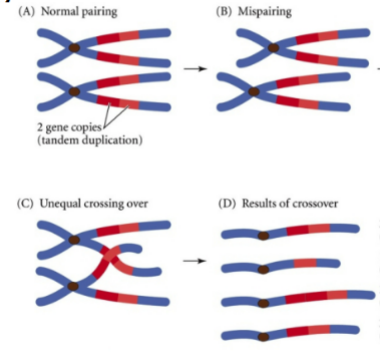
What is a karyotype?
description of an organism’s complement of chromosomes;
their number, size, shape and internal arrangement
What happens if the alteration to karyotype mutation results in an aneuploid (unbalanced) chromosome pair
Gametes and/or organism are unviable (with the exception of trisomy 21)
What is polyploidy?
Changes in the number of whole sets of chromosomes
-usually occurs during meiosis
-for diploid organisms, produces >2N individuals
-Species of plants (angiosperms), trout, tree frogs produced in this manner...and now crayfish
Types of chromosome rearrangements (alteration of karyotype)
-inversion (chromosome gets twisted up)
-fission and fusion (cut or two diff chromosomes out together)
What type of mutations can be passed on? Somatic or germ-line
germ-line
What are the consequences of mutations?
1. Can alter product itself
2. Can alter amount
produced
3. Can alter when produced
4. Can alter where produced
True or false: no two gametes are identical
true
What is the polyphenism?
multiple, discrete phenotypes made from 1 genotype
What is phenotypic plasticity
changes in phenotype in response to different
environments
True or false: the same phenotype can be produced from multiple different genotypes?
True
What is a genetic locus?
location of a specific gene or sequence of DNA on a
chromosome
-Alleles are mutually exclusive alternative states for a genetic locus
What are the Hardy-Weinberg equilibrium assumptions?
1. Population is infinitely large
2. Genotypes do not differ in fitness
3. There is no mutation
4. Mating is random
5. There is no migration
What are the five causes of evolution?
genetic drift
natural selection
mutations
non-random mating
gene flow
What is genetic drift?
Changes in the gene pool of a non-infinite population due to chance
AKA The random walk of nature
change is the default in finite populations
“sampling error”- the smaller the sample, the greater the chance of deviation from the expected results
What cause alleles to be lost faster in small populations?
bottlenecks (a form of genetic drift)
founder effect- When individuals colonize a new region, they often contain a less-
than representative sample of the original population’s gene pool
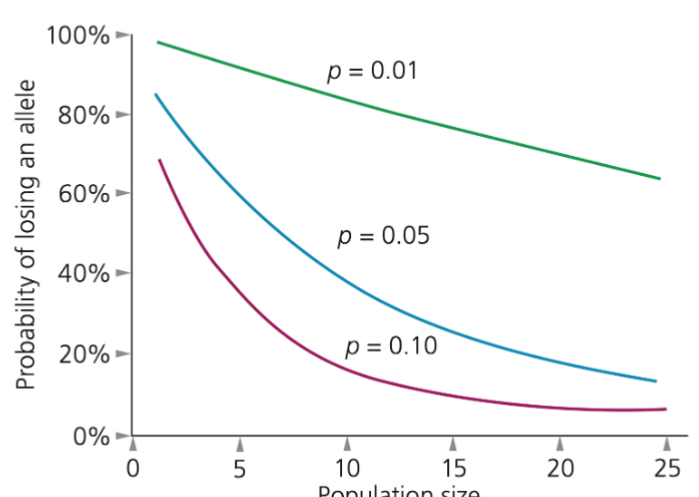
What does this graph tell us?
Rare alleles are likely to be lost during a
bottleneck
What is directional selection?
w1w1 ≥ w1w2 > w2w2 (one homo is the worst, hetero is medium, other homo is the best)
True or false: natural selection is less powerful in large populations?
False
drift is weaker in large populations
small advantages in fitness can lead to large changes over time
What is pleiotropy?
mutation in a single gene affects many phenotypic
traits
Can be antagonistic (a mutation with beneficial effects for one trait
also causes detrimental effects on other traits)
Net effect on fitness determines outcome of selection
What is epistasis?
when the effects of an allele at one genetic locus are modified by alleles at one or more other loci
What factors affect speed of fixation or loss?
rarity, allele relationships, and population size
How does rarity affect time to allele fixation or loss?
unless rare allele can increase in frequency, unlikely to become fixed
What are the two types of allele relationships and how do they affect time to allele fixation or loss?
Additive/Intermediate
allele yields twice the phenotypic effect when two copies present
Dominance
dominant allele masks presence of recessive in heterozygote
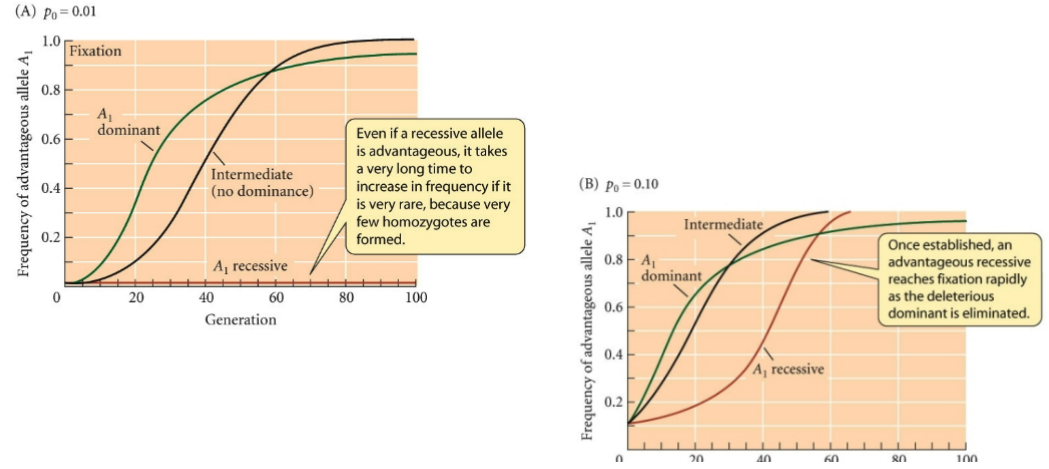
How does population size affect allele fixation or loss?
Slightly advantageous mutation is less likely to be fixed by selection if the population is small (can be eliminated via drift before it makes an impact)
What is balancing selection and the two types?
a form of selection that maintains diversity in populations by reducing fixation rates
Two types are Negative frequency-dependent selection and
Heterozygote advantage (w1w1 < w1w2 > w2w2)
What is inbreeding depression and what is the mechanism that causes it?
reduced reproductive success and survival of offspring when parents are closely related
The mechanism is expression of deleterious recessive alleles
What is Fst?
a measure of genetic distance, the reduction in heterozygotes at a locus attributable to the effects of population subdivision
If Fst is high, is gene flow low or high?
low
Does gene flow reduce or increase fixation and loss of alleles in populations?
reduce
Genetic drift effect on variation and strength
decrease, strong in small populations, weak in large
Mutation effect on variation and strength
increase, weak
natural selection effect on variation and strength
decrease, weak(?)
Gene flow effect on variation and strength
decrease, strong(?)